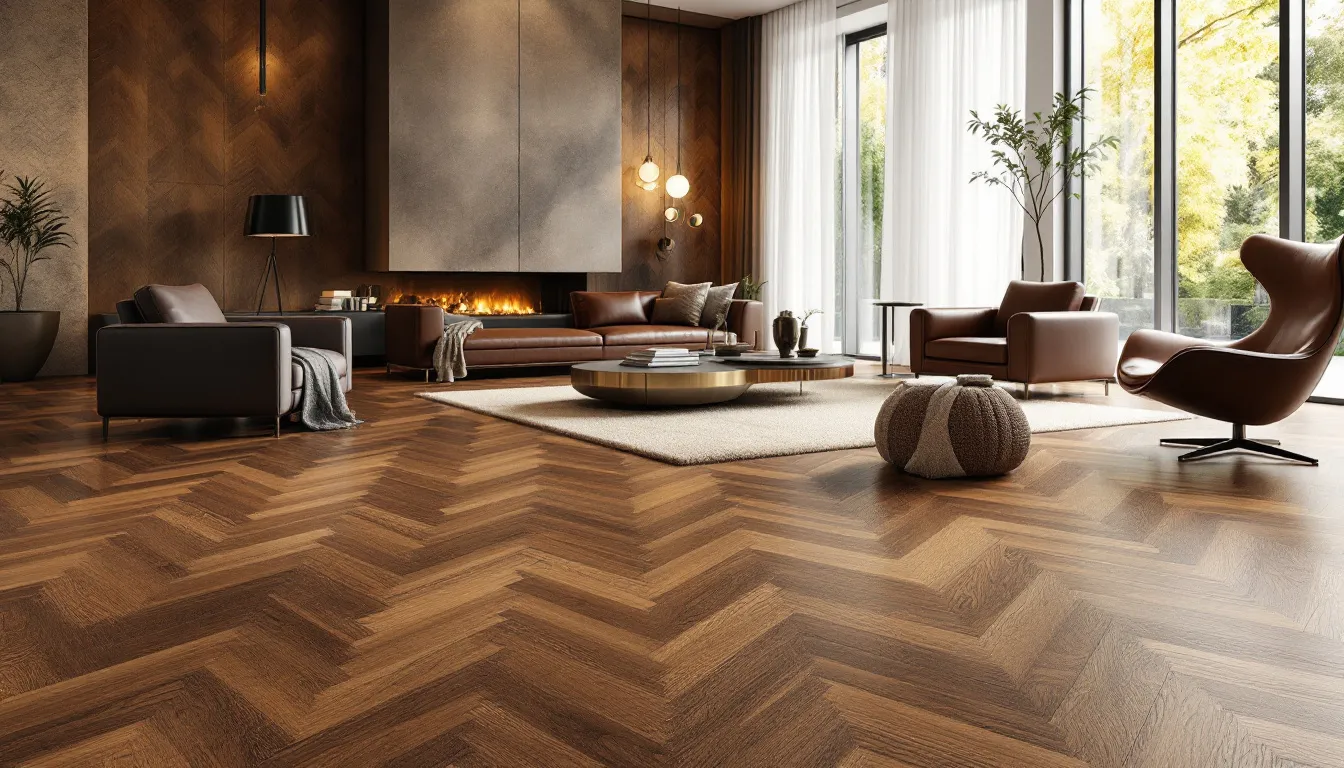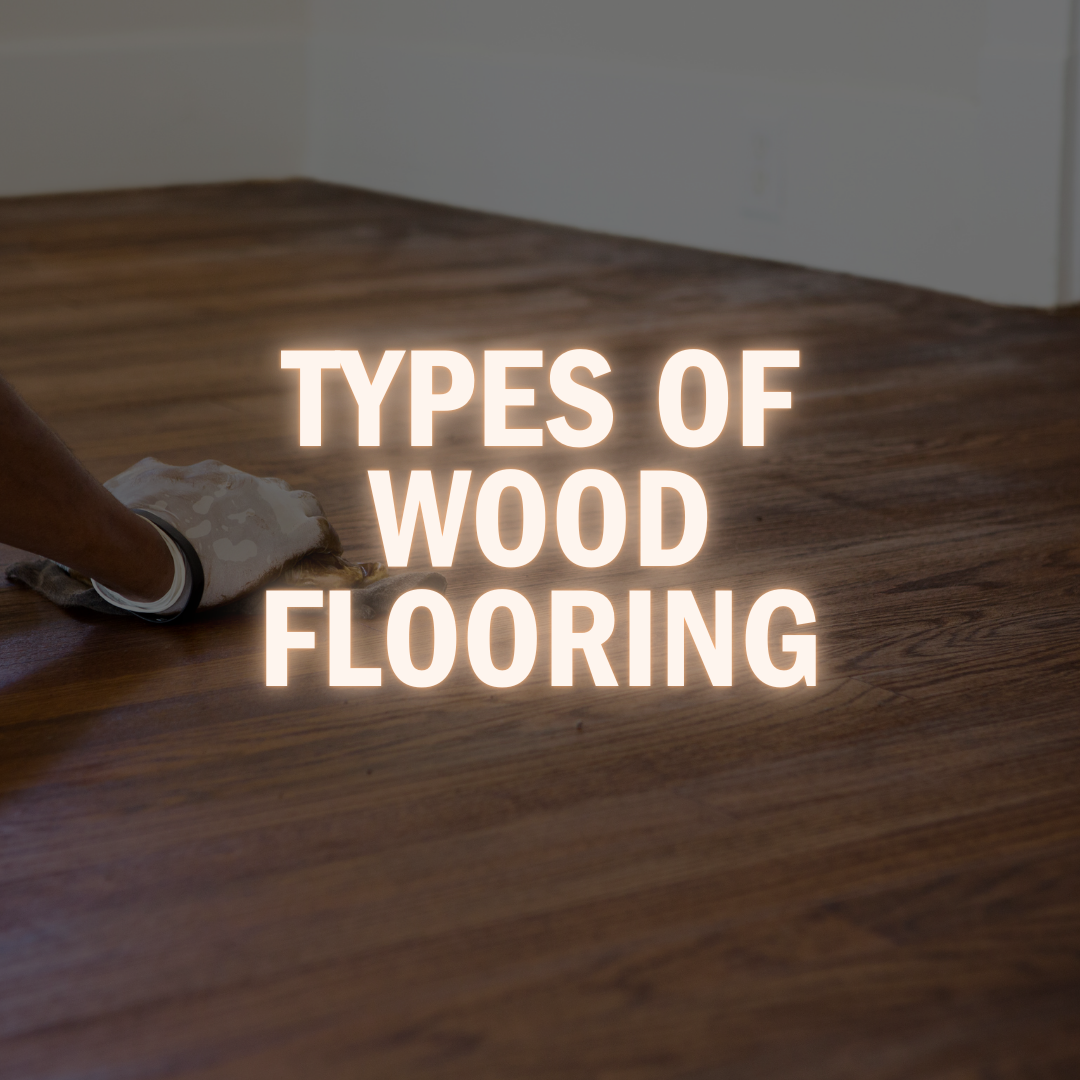
Want a flooring option that screams style and can survive Malaysia’s humidity? Let’s cut through the noise. Whether you're upgrading a condo in KL or building your dream home in Penang, your flooring sets the tone. This no-fluff guide breaks down the best wood flooring options, their strengths, and where they shine — so you can make a confident, future-proof choice.
Solid Hardwood Flooring — Timeless Prestige. Built to Impress.

Solid hardwood flooring is the epitome of traditional wood flooring. Made from a single piece of natural wood, it offers unparalleled durability and timeless appeal. One of the main attractions of solid wood floors is their ability to withstand wear over decades.
Although the initial cost may be high, the longevity and low maintenance make it a cost-effective choice in the long run. Moreover, prefinished hardwood flooring can enhance the aesthetics of your home, making it feel warmer and more inviting. Solid timber flooring is an excellent option for those seeking quality and elegance.
You’re not just buying a floor — you’re making a statement. Solid hardwood flooring screams sophistication. Carved from a single block of timber, it brings that rich, warm, high-end finish no vinyl or laminate can fake.
But let's get real — this isn’t for every home. Malaysia’s humidity can turn your dream floor into a warped mess without proper prep. You need the right species, right coating, and right care to make it last.
✅ Why It Wins:
- Looks better with age (like a vintage car)
- Can be sanded and refinished again and again
- Adds real value to your property (especially for landed homes)
⚠️ Heads Up:
- RM18–RM40/sqft (quality comes at a price)
- Not suitable for humid, enclosed spaces
- Needs regular upkeep (but it’s worth it)
Best for: Master bedrooms, living rooms, landed properties with air-flow and ventilation.
Engineered Wood Flooring

Engineered wood is what smart homeowners in Malaysia are choosing. Why? It looks like solid wood but performs better in our hot and humid environment. With a real wood veneer on top and plywood layers below, it’s more stable and water-resistant.
Pros:
- Real wood aesthetics
- Handles humidity better than solid wood
- Easier to install (hello, click-lock!)
Cons:
- Can’t be sanded too often
- Avoid bathrooms or wet kitchens
Best for: Condos, high-rise units, living and dining areas.
Want the hardwood look without the high-maintenance drama?
Engineered wood’s your secret weapon.
Bamboo Flooring
Fast-growing, eco-friendly, and seriously stylish. Bamboo is a renewable resource and offers decent durability. But don’t get it twisted — it’s not waterproof. Still, it’s a strong pick for eco-conscious homeowners.
Pros:
- Sustainable and stylish
- Naturally water-resistant
- Cost-effective (RM10 – RM25/sqft)
Cons:
- Can emit VOCs (check the label)
- Not for wet areas
Best for: Bedrooms, study rooms, or anywhere you want a modern Zen vibe.
Want your floors to look good and save the planet?
Bamboo brings both.
Laminate Flooring — Wood Look Without the Wallet Burn

Laminate’s your go-to when budget matters but you still want the wood look. Easy to install, clean, and scratch-resistant — perfect for young families or rental units. But here’s the catch: moisture is the enemy.
Pros:
- Budget-friendly (RM6 – RM15/sqft)
- Scratch-resistant
- DIY-friendly
Cons:
- Not moisture-proof
- Can’t be sanded or refinished
Best for: Living rooms, bedrooms, dry office spaces.
Tight budget? No worries. Laminate makes wood-look
floors achievable — no renovation regrets.
Luxury Vinyl Plank (LVP) — Waterproof Wood Look? Yes, Please
Vinyl plank flooring is the rising star in Malaysia’s interior scene. It mimics real wood, is 100% waterproof, and stands up to traffic, spills, and humidity. Ideal for kitchens, bathrooms, and everywhere in between.
Pros:
- Waterproof and scratch-resistant
- Easy to install and maintain
- Great for Malaysian weather
Cons:
- Lower resale value than wood
- Feels slightly synthetic underfoot
Best for: Kitchens, bathrooms, condos, family homes.
Want hassle-free, kid-proof, moisture-proof floors?
LVP is your MVP.
Parquet Flooring — Statement Style

Parquet flooring is known for its intricate geometric patterns, made from smaller slabs arranged in designs like herringbone, chevron, and basketweave. This type of flooring can be made from either solid or engineered wood blocks, offering a unique aesthetic appeal that can enhance the visual interest of any room.
While parquet flooring is best suited for low-moisture, high-traffic areas such as living rooms, it should be avoided in humid areas like bathrooms and laundry rooms. If you want your floor to wow, parquet is the way to go. Herringbone, chevron, and other geometric designs add elegance and sophistication. But it’s a diva — avoid wet areas.
Pros:
- Visually striking
- Premium feel
- Boosts resale value
Cons:
- Labor-intensive installation
- Pricey (RM25 – RM40/sqft)
Best for: Feature walls, formal dining rooms, showpiece living areas.
Want floors that impress every guest?
Parquet turns heads.
Wood-Effect Ceramic Tiles
Love the look of wood but want bathroom durability? Wood-effect ceramic tiles deliver. They’re tough, water-resistant, and ideal for wet zones — without sacrificing style.
Pros:
- Waterproof
- Heat-friendly (great for underfloor heating)
- Lasts 20–50 years
Cons:
- Hard underfoot
- Needs grout maintenance
Best for: Bathrooms, kitchens, commercial spaces.
Real wood can’t handle your bathroom?
These tiles can.
Cork Flooring
Cork flooring is made from the bark of the cork oak tree, offering a soft, warm, and soundproof flooring option suitable for bedrooms and playrooms. Its cellular structure provides excellent thermal insulation, making it comfortable underfoot and suitable for various climates. Cork flooring stays cool during hot weather while remaining warm in winter, enhancing comfort throughout the year.
Despite its many benefits, cork flooring can be prone to scratches and dents due to its softer nature. In humid areas, it can warp, discolor, and curl. Additionally, its color can fade if exposed to direct sunlight for long periods.
The starting price for cork flooring is more expensive than laminate and vinyl flooring.
Pros:
- Sound-absorbing
- Soft underfoot
- Eco-friendly
Cons:
- Prone to scratches
- Not for high-humidity areas
Best for: Bedrooms, playrooms, creative studios.
Want floors that feel like clouds?
Cork is your vibe.
Reclaimed Wood Flooring
Every plank has a past. Reclaimed wood adds heritage and sustainability to your home. Reclaimed wood flooring is made from salvaged wood from another property, showcasing natural signs of wear and adding a unique character to any space. This type of flooring is known for its durability, high resale value, and environmental friendliness.
One of the main appeals of reclaimed wood flooring is its sustainability, as it repurposes existing materials and reduces the demand for new wood. It can be costly. This is due to the labor-intensive process of sourcing and removal.
Despite the higher cost, reclaimed wood flooring is best suited for bedrooms, dens, and living rooms, but it is not recommended for bathrooms due to its susceptibility to moisture.
Reclaimed wood flooring offers a blend of history, character, and sustainability, making it a unique and valuable addition to any home.
Pros:
- Unique character
- Environmentally friendly
- High resale value
Cons:
- Pricey and rare
- Needs careful prep and sealing
Best for: Statement floors, rustic homes, eco-luxe projects.
Want your floor to tell a story?
Reclaimed wood speaks volumes.
Installation Methods for Wood Flooring
There are various installation methods for wood flooring, each with its own set of advantages and considerations. Tongue-and-groove flooring, which can be installed using glue, nails, or as a floating floor, offers versatility and a secure fit. However, repairs can be complex, as multiple boards may need to be removed to access a damaged one.
Click-lock flooring is another popular option, known for its ease of installation and removal. This method allows for tight joints and the ability to detach individual planks without damaging others, making it a favorite among DIY enthusiasts.
Floating floors, which require a solid subfloor for stability, can be installed over existing floors without nails or screws, offering a quick and straightforward solution.
The installation of parquet flooring can be intricate and may require skilled professionals, especially for traditional designs. Regardless of the method chosen, proper installation is crucial for the longevity and performance of wood flooring.
Which Installation Method is Right for You?
- Click-Lock: Fast and easy. Ideal for DIY jobs.
- Glue-down: Stronger hold. Great for engineered wood.
- Nail-down: Best for solid hardwood. Needs pro handling.
- Floating floor: Quick install over existing flooring.
Not sure which suits your space?
We’ll help you decide — zero pressure.
Pro Maintenance Tips to Keep It Flawless
- Sweep and vacuum regularly.
- Use furniture pads — avoid scratches.
- Wipe spills ASAP to prevent stains or swelling.
- Avoid harsh cleaners — go for pH-neutral wood-safe options.
Bonus tip: Refinish solid wood floors every few years for a fresh look.
Investment Value of Wood Flooring

Installing wood flooring can significantly increase the resale value of your property. Hardwood floors, in particular, are favored by homebuyers for their durability and timeless elegance. New flooring can increase a property’s value by approximately 2-5%, influenced by the material used. The choice of flooring type affects resale value, with hardwood often yielding the highest returns.
Installing hardwood flooring can lead to a return on investment between 70-80% when the home is sold. High-quality parquet flooring can also increase the overall value of a property due to its luxurious appearance and functionality. The longevity of wood flooring compensates for its cost, making it a worthwhile investment for homeowners.
Addressing Common Concerns
Common concerns about wood flooring often revolve around moisture, allergens, and termites. Immediate cleaning of moisture on wood floors helps prevent water damage and subsequent susceptibility to termites. No wooden flooring type is impenetrable to water, and seepage can cause extraordinary damage and potential rotting. Preventive measures against termites include minimizing soil moisture around foundations and reducing wood-to-soil contact.
Hardwood flooring can enhance the acoustics within a space, reducing unwanted sounds and vibrations. These floors are quieter underfoot, contributing to a more peaceful living environment. Additionally, hardwood floors improve indoor air quality by not trapping allergens like dust and animal dander, making them a suitable option for allergy sufferers.
Choosing the Right Wood Flooring for Each Room
Different rooms in your home require specific types of wood flooring based on their function and the expected foot traffic. Engineered wood flooring is known for its durability, making it suitable for high-traffic areas. Strand woven bamboo, which is significantly harder than oak, is also a great option for these areas. The aesthetics of wood flooring can greatly influence the overall design and feel of a room.
Parquet flooring’s aesthetic charm may not suit all interior styles, particularly ultra-modern or minimalist designs. The quality of wood flooring affects not only its appearance but also its durability and maintenance requirements. By choosing the right wood flooring for each room, you can enhance both the functionality and beauty of your home.
Summary
In conclusion, choosing the best type of wood flooring for your home involves considering various factors such as durability, maintenance, aesthetics, and the specific needs of each room. Solid hardwood flooring offers timeless beauty and longevity, while engineered wood provides enhanced stability and water resistance. Bamboo and cork flooring are excellent eco-friendly options, and luxury vinyl plank flooring combines the look of wood with modern durability.
By understanding the unique features and benefits of each type of wood flooring, you can make an informed decision that aligns with your style, budget, and lifestyle. Investing in quality wood flooring not only enhances the beauty of your home but also adds significant value, making it a worthwhile investment for years to come.
The Types Of Wood Flooring We Trust – And Why You Should Too
You’ve seen the pros and cons. You know what works best in each room. Now here’s what we actually offer — no fluff, no fillers.
🌲 Merbau – Tropical hardwood that holds up in Malaysia’s heat and humidity. Dense, stable, and termite-resistant.
🌲 Chengal – One of Malaysia’s strongest timbers. Withstands foot traffic and weather like a champ.
🌲 Kempas – Mid-range pricing, beautiful tone, and strong wear resistance. Great bang for buck.
🌲 Oak – We pre-treat and season it for our weather. Classic style meets modern tech.
🌲 Teak – An extremely durable hardwood with a beautiful golden-brown hue, highly resistant to rot and pests.
🌲 Balau – A heavy, yellow to brown timber known for its strength and natural durability, often used in heavy construction.
🌲 Nyatoh – A popular timber for furniture and interior finishing, offering a balance between affordability and aesthetics.
🌲 Red Meranti – A lightweight timber with a dark red hue, commonly used for interior applications.
🌲 Resak – A timber known for its strength and durability, often used in heavy construction and flooring.
More Info Here: Resilient Timber Floor Wood Type
Whether you want rustic warmth or sleek elegance, we’ve got the right timber for you

💬 Thinking of solid wood but not sure of the flooring types that fit your space?
👉 [Talk to a Flooring Consultant Now]
Let us help you choose the best timber type that actually works in Malaysia’s climate — without the headaches.
Frequently Asked Questions (FAQs)
What is the main difference between solid hardwood and engineered hardwood flooring?
The main difference between solid hardwood and engineered wood flooring is that solid hardwood is made from a single piece of natural wood, while engineered wood features a real wood veneer atop multiple layers of plywood, offering greater stability and moisture resistance.
Is bamboo flooring a sustainable & eco friendly option?
Yes, bamboo flooring is a sustainable option since bamboo grows rapidly and can be harvested without causing significant environmental impact, making it an eco-friendly alternative to traditional hardwoods.
Can laminate flooring be installed in high-moisture areas?
Laminate flooring is not suitable for high-moisture areas due to its susceptibility to moisture damage. It's best to opt for alternatives designed for such environments.
How does luxury vinyl plank flooring compare to laminate flooring in terms of water resistance?
Luxury vinyl plank flooring outperforms laminate flooring in water resistance, making it a better choice for moisture-prone areas such as bathrooms and kitchens.
What are the benefits of reclaimed wood flooring?
Reclaimed wood flooring offers durability, environmental sustainability, and distinct character that enhances your home's aesthetic. Additionally, it tends to have high resale value, making it a smart investment.
How long will my wood flooring last?
With proper care:
- Solid hardwood: 30–100 years
- Engineered wood: 25–30 years
- Vinyl: 15–20 years

Leave a Reply
Your email address will not be published. Required fields are marked *

